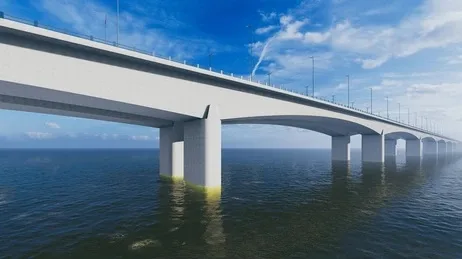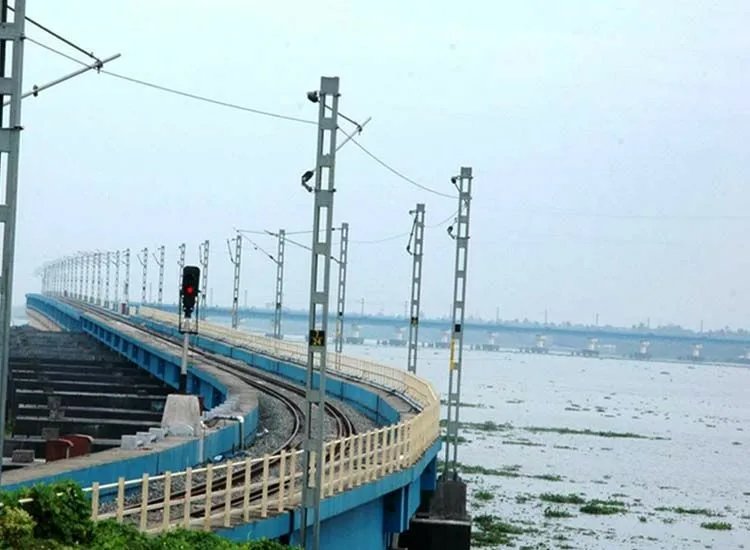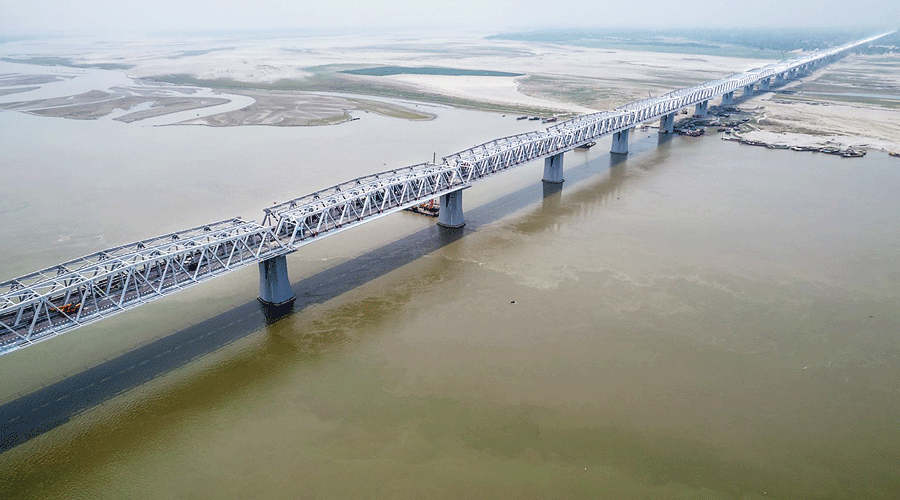A beam type bridge consists of a horizontal beam supported by piers or abutments at each end. The beam is made of steel, concrete, or wood, spans across the gap, distributing the load and supporting the bridge’s weight. The key function of this type of bridge is the load distribution, as weight is applied, the beams bear the load and transfer it to the supporting piers or abutments.
Structural parts of a beam bridge
- Deck: The horizontal surface that supports the traffic or loads. It’s the part you walk or drive on.
- Beams: The main horizontal element spans between the supports (piers or abutments) and supports the deck.
- Supports: These are the structures at either end of the bridge that hold up the beams. Supports can be piers (vertical columns) or abutments (horizontal supports against the banks of the obstacle).
- Substructure: The part of the bridge that supports the beams and includes the piers or abutments.
- Superstructure: The part of the bridge that is above the piers or abutments, including the beams and the deck.
Advantages of beam bridge
- Distribute loads primarily through axial compression and tension forces along the beams. The load distribution in beam bridges is relatively uniform across the length of the beams.
- Can be supported by various types of foundations, including simple piers, abutments etc.
- Can be designed into curved or skewed beams as per specific alignment requirements.
- Due to their uncomplicated design, beam bridges are relatively easy to construct.
- Can be constructed using a variety of materials, such as wood, concrete, or steel.
Types of beam bridges
1. Simple Beam Bridge:
A simple beam bridge is the most basic design, comprising horizontal beams supported by piers or abutments. These bridges are commonly used for relatively short spans, such as crossing small rivers or streams. The simplicity of their design makes them cost-effective and easy to construct, making them suitable for various applications in local infrastructure.

2. Cantilever Beam Bridge:
A cantilever beam bridge is a type of bridge structure supported on one end, with the main span extending horizontally and anchored on one or both sides. It relies on cantilevered segments that project outward from supporting piers or abutments, creating a balanced structure. This design allows for the construction of longer spans without the need for additional support in the middle, making it suitable for spanning over obstacles like rivers or deep gorges.

3. Arch Beam Bridge:
An arch beam bridges have a distinctive arch shape, which efficiently distributes weight along the curve. This design is commonly used for aesthetic purposes in addition to its structural benefits. Arch bridges are suitable for moderate spans and are often chosen for their architectural appeal, enhancing the visual landscape of the surrounding environment.

4. Suspension Beam Bridge:
A suspension beam bridge utilize cables anchored to towers to support the bridge deck, allowing for longer spans than many other types. These bridges are ideal for spanning large bodies of water or areas with challenging topography. The iconic Golden Gate Bridge is an example of a suspension bridge, showcasing their ability to provide both strength and elegance in long-span applications.

5. Truss Beam Bridge:
A truss beam bridge feature a framework of connected triangles (trusses) that provide added strength and stability. This design is highly efficient in distributing loads, making it suitable for both short and medium spans. Truss bridges are commonly used in highway and railway infrastructure due to their versatility, strength, and relatively straightforward construction.

6. Girder Beam Bridge:
A girder beam bridge rely on girders (horizontal beams) to support the bridge deck. This type is commonly used in highway and railway bridges, providing a simple and effective solution for various spans. Girder bridges are known for their durability, ease of construction, and suitability for carrying heavy loads, making them a popular choice for transportation infrastructure projects.

Factors to consider for the design of a beam bridge
- Distinguish between different load types, such as concentrated loads, distributed loads, and dynamic loads.
- Consider the specific types of beams, such as simply supported, cantilever, or continuous beams, based on the bridge’s design requirements.
- Define the material properties, including elastic modulus, yield strength, and other mechanical characteristics, to accurately simulate how materials will respond to loads.
- Determine the optimal cross-sectional shape and dimensions of the beams, accounting for factors like bending, shear, and torsion.
- Specify the design of the bridge deck, including its thickness, materials, and any reinforcing elements like steel mesh or bars.
- Consider the influence of various factors on load distribution, such as the rigidity of supports, the flexibility of beams, and the interaction between different components.
- Establish permissible deflection limits to ensure bridge’s vertical and lateral movement under different loads.
- Perform fatigue analysis to assess the potential for long-term material fatigue due to repeated loading and unloading.
- Design and specify the details of connections between different structural elements, such as beams and supports,.
These considerations collectively contribute to a comprehensive and precise design of a beam bridge, meeting both safety standards and functional requirements.
Construction method of beam bridge
Here’s a step-by-step overview of how a beam bridge is typically constructed:
- Clear the construction site and ensure the foundation is stable and properly leveled.
- Construct abutments or piers, which are the vertical supports for the bridge.
- Fabricate the horizontal beams off-site using materials such as steel, concrete, or wood.
- Hoist and position the beams horizontally on top of the abutments or piers.
- Connect the beams securely to the abutments or piers, ensuring stability.
- Install the bridge deck, which is the surface that vehicles or pedestrians will use.
- Add guardrails and sidewalks, if required, for safety and functionality.
- Conduct inspections to ensure the construction meets safety and engineering standards.
- Verify that the bridge is level, stable, and capable of supporting its intended load.
Applications of beam bridges
- Highways and Roads
- Pedestrian
- Railway Crossings:
- Rural Roads:
- Emergency or Temporary Crossings
- Utility Crossings
Famous beam bridges in India






Conclusion
Beam bridges are fundamental yet efficient bridge types relying on simple supports to carry loads across spans. Their straightforward design, cost-effectiveness, and ease of construction make them prevalent across various applications. As technology evolves, innovations in materials and design continue to enhance the efficiency and resilience of beam bridges, ensuring their continued relevance in infrastructure projects worldwide.

